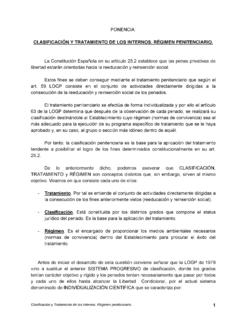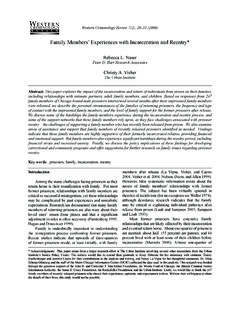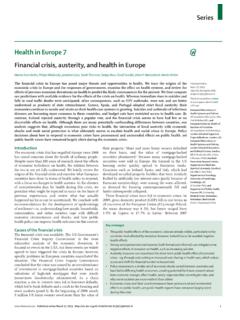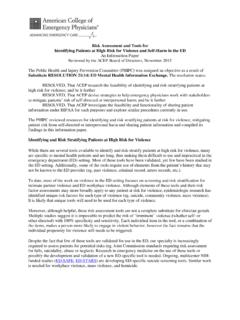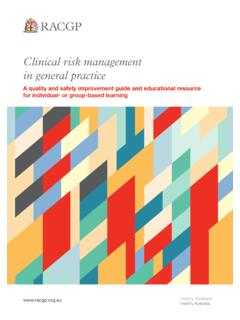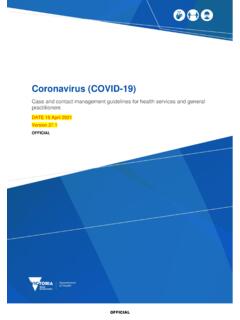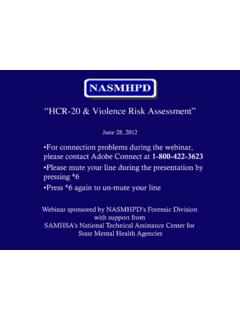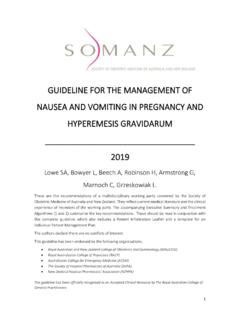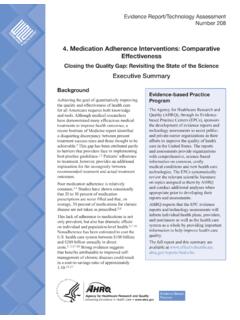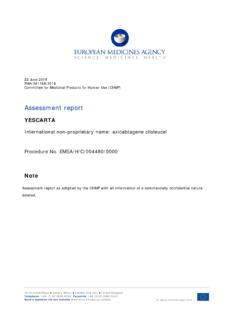Transcription of Historical-Clinical-Risk Management-20, Version 3 (HCR-20 ...
1 Historical-Clinical-Risk management -20, Version 3(HCR-20V3): Development and OverviewKevin S. DouglasDepartment of Psychology, Simon Fraser University, Burnaby, Canada; Department of SocialSciences, Mid-Sweden University, Sundsvall, SwedenStephen D. HartDepartment of Psychology, Simon Fraser University, Vancouver, British Columbia, CanadaChristopher D. WebsterDepartment of Psychiatry, University of Toronto, Toronto, Canada; Department of Psychology,Simon Fraser University, Burnaby, Canada; Forensic Psychiatric Services Commission ofBritish Columbia, Vancouver, Canada; Child Development Institute, Toronto, Canada;Centre for Mental Health and Addiction, Toronto, CanadaHenrik BelfrageVadstena Forensic Psychiatric Hospital, Vadstena, Sweden; Department of Social Sciences,Mid-Sweden University, Sundsvall, SwedenLaura S. GuyDepartment of Psychiatry, University of Massachusetts Medical School, Worcester,Massachusetts, USA; ProActive Resolutions, Inc.
2 , Vancouver, British Columbia, CanadaCatherine M. WilsonDepartment of Psychiatry, University of British Columbia, Vancouver, British Columbia,Canada; British Columbia Forensic Psychiatric Services Commission, Port Coquitlam, BritishColumbia, Canada; British Columbia Mental Health and Substance Use Services, Vancouver,British Columbia, CanadaThe HCR-20 Version 3 (HCR-20V3) was published in 2013, after several years of developmentand revision work. It replaces Version 2, published in 1997, on which there have been morethan 200 disseminations based on more than 33,000 cases across 25 countries. This articleexplains (1) why a revision was necessary, (2) the steps we took in the revision process, (3)key changes between Version 2 and Version 3, and (4) an overview of HCR-20V3 s riskfactors and administration steps. Recommendations for evaluating Version 3 are :violence risk assessment, HCR-20V3 The opening words of both HCR-20 Version 1 (Webster,Eaves, Douglas, & Wintrup, 1995, p.)
3 V) and Version 2(Webster, Douglas, Eaves, & Hart, 1997, p. 1) were that [t]he challenge in what remains of the 1990s is to integratethe almost separate words of research on the prediction ofviolence and the clinical practice of assessment. And, Ver-sion 1, penned nearly two decades ago, closed by warningthat [g]iven the present rate of publication in this area, itcan be argued, this system will date quite thesame time, it is thought that the scheme should serve as anAddress correspondence to Kevin S. Douglas, Department of Psy-chology, Simon Fraser University, 8888 University Drive, Burnaby, BC,Canada V5A 1S6. E-mail: JOURNAL OF FORENSIC MENTAL HEALTH, 13: 93 108, 2014 Copyright International Association of Forensic Mental Health ServicesISSN: 1499-9013 print / 1932-9903 onlineDOI: by [ ] at 23:40 26 August 2015 important starting point for new research (Webster et al.,1995, p. 50). Indeed, we published a revised HCR-20 amere two years after Version 1 was released in our view, important strides have been made over thepast two decades toward fulfilling our early hopes thatthe HCR-20 could both stimulate research and facilitatethe integration of this research with clinical practice.
4 TheHCR-20 (primarily Version 2) has been subjected to morethan 200 empirical evaluations (see Douglas, Shaffer, et al.,2014, for an annotated bibliography). It has been translatedinto 20 languages, and adopted or evaluated in agencieswithin 35 countries. A recent large-scale survey by Singh(2013) of 2,135 clinicians across 44 countries indicated thatthe HCR-20 was the most commonly used violence riskassessment instrument both in terms of assessing risk andcreating risk management plans. We have little doubt thatthis widespread adoption of the HCR-20 is attributable bothto its extensive evaluation by independent researchers, andto its clinical will not review here the ever-growing research base onthe HCR-20 and the Structured Professional Judgment (SPJ)model of violence risk assessment and management morebroadly. That task has been done before (for reviews, seeDouglas, in press; Douglas, Hart, Groscup, & Litwack, 2014;Guy, Hart, & Douglas, in press; Heilbrun, Yasuhara, & Shah,2010; Webster, Haque, & Hucker, 2014).
5 In our view, theresearch base and meta-analytic reviews indicate that theHCR-20 performs as well as or better than in terms of pre-dictive validity other approaches (for meta-analytic reviews,see Campbell, French, & Gendreau, 2009; Fazel, Singh, Doll,& Grann, 2012; Guy, 2008; Guy, Douglas, & Hendry, 2010;Singh, Grann, & Fazel, 2011; Yang, Wong, & Coid, 2010).However, we realize that others might have different views,and we will leave that discussion for other question arises, then, why revise the HCR-20? Thisarticle answers that question, and then provides an over-view of Version 3 of the HCR-20 (Douglas, Hart, Webster,& Belfrage, 2013), along with how it was developed. First,we will give a brief overview of the SPJ model. Second, wewill delineate the rationale for revising the HCR-20, alongwith our goals for the revision. Third, we will describe therevision process itself. Next, we will outline the key fea-tures of HCR-20V3and primary changes from Version , we will discuss the administration procedures ofHCR-20V3.
6 Finally, we will conclude with recommenda-tions for evaluating STRUCTURED PROFESSIONAL JUDGMENTMODEL OF VIOLENCE RISK ASSESSMENTAND MANAGEMENTT here are many published descriptions of the SPJ modeland how it differs from other approaches (Douglas, in press;Douglas, Hart, et al., 2014; Douglas & Reeves, 2010; Guyet al., in press; Hart, 1998; Heilbrun et al., 2010; Pritchard,Blanchard, & Douglas, 2014; Webster et al., 2014), includ-ing in the Version 3 manual itself (Douglas et al., 2013).As such, we will provide only a brief description of themain elements and goals of the SPJ approach, which theHCR-20 Version 3 exemplifies and measures typically include 20-30 risk factors chosenon the basis of a thorough review of the scientific literature,rather than based on the results of a single or small numberof samples. This is done to enhance comprehensiveness ofcoverage in terms of risk factors, and to promote generaliz-ability across settings and samples.
7 The approach helps eval-uators and decision-makers identify risk factors that arepresent and relevant to the individual being evaluated; riskreduction and management strategies; and relative risk measures adopt non-algorithmic, non-numeric deci-sion processes and risk estimates. They do so to avoid thepitfalls inherent in actuarial approaches, such as sampledependence, exclusion of potentially important risk factors,instability of precise probability estimates across samples,and the inherent difficulty in applying group-based proba-bility estimates to individuals. The SPJ model, rather, usesa simple, narrative approach to risk estimation, requiringevaluators to come to a decision of low, moderate, or highrisk. This estimate derives from the number and relevanceof risk factors, the corresponding concern that a person willbe violent in the future, and the anticipated nature andintensity of intervention or management strategies neces-sary to mitigate risk (see Douglas, Hart, et al.)
8 , 2014, for areview). As described by Douglas (in press),[a]lthough specific cut-points are not provided, generally,the more risk factors that are present, the higher the risktypically will be. The greater the intervention efforts thatwould be required to stem risk, the higher the risk. The SPJapproach allows for exceptions to this general rule. If, forinstance, a person has a small number of highly compellingrisk factors ( , threats of homicide and a history of actingon said threats) a decision of high risk could be non-algorithmic, professional approach to risk estima-tion has been shown in many studies to be as or more accu-rate vis- a-vis future violence compared to numerically-based estimates (for reviews, see Guy, 2008; Guy et al., inpress; Heilbrun et al., 2010; Singh et al., 2011).The SPJ approach is ultimately geared toward informingrisk management plans so as to facilitate risk reduction. AllSPJ instruments contain dynamic, or changeable, risk fac-tors.
9 A large part of using SPJ approaches involves deter-mining which dynamic risk factors are present andrelevant, and using those to shape, monitor, and revise man-agement plans over time. Most recently, the SPJ approachhas expounded upon the benefit of case formulation andscenario planning to achieve the goals of optimal risk man-agement and risk reduction (Douglas, Blanchard, & Hendry,2013; Hart & Logan, 2011; Hart, Sturmey, Logan, &94 DOUGLAS ET by [ ] at 23:40 26 August 2015 McMurran, 2011; Lewis & Doyle, 2009). We next turn to thegoals for revising the FOR AND GOALS OF THE REVISIONR ationaleIn 1995, we identified the risk that the HCR-20 could becomedated without periodic revisions. Since the publication ofVersion 2 in 1997, there have been literally thousands ofresearch studies on violence generally. As such, one of themain reasons for revision was to ensure that the HCR-20 con-tinues to reflect contemporary scholarship on violence, interms of the risk factors that it contains.
10 The HCR-20 aswith all SPJ instruments is intended to be a comprehensiveset of professional guidelines. As such, it must reflect contem-porary knowledge on violence. Although we did not expect tocome across completely new risk factors, we did think it pos-sible that revisions to some HCR-20 risk factors might bewarranted given new developments in research. Further, itwas possible that certain new risk factors should be includedin the HCR-20, and perhaps some modified or dropped. Forinstance, research indicates that being victimized by violenceas an adult can elevate one s risk for violence (Desmaraiset al., 2014; Swanson et al., 2002). This was not directlyreflected in Version 2. In Version 3, it , SPJ scholarship has evolved considerably since1997. At that point, much of the concern in the field was toidentify the most important risk factors to include on riskassessment instruments. Less attention was paid to the deci-sion-making process, and the link to risk management .

